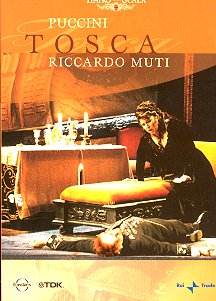There is no doubt who is being trumpeted as the main
draw here. Muti’s name appears as boldly as Puccini’s on the front cover,
with everyone else reduced to small print on the back. Well, in these
days of marketing machines, who can blame them? Indeed, there was a
time in my student days when a new Muti recording was a real event,
keenly anticipated. The results were not usually disappointing; I think
fondly of his Carmina Burana, Pictures at an Exhibition,
Scriabin Symphonies and Aida, to name a few. These performances
generally stood out for their controlled abandon, exciting rhythmic
drive and ecstatic climaxes, qualities that are in short supply here.
That’s not to say there aren’t things to enjoy in his conducting. Now
in his sixties, the accent seems to be more on lovingly shaped lyricism
and a refusal to give us ‘technicolour’ big moments. This no-nonsense
approach is evident from the start, as the camera watches him come smartly
into the pit, brief acknowledgements, then straight in with a clean,
fairly swift rendition of the big, dramatic opening Scarpia motif. He
never lets the singers linger over high notes (as at the end of Cavaradossi’s
first aria, Recondita armonia) but waits, in an almost symphonic
fashion, for true climactic points, such as Scarpia’s first appearance
(Bel rispetto!). This does give cohesion to the whole piece,
and the last act, too often seen as a weak epilogue to the main drama
(i.e., Scarpia and Tosca) emerges with beautifully controlled passion
and warmth. The Scala forces, who must know this score by heart, play
well for him, the strings having a supple, singing quality that could
withstand any comparison.
So the orchestral texture is certainly a pleasure to
listen to. Of the singers, I had little cause for complaint with any
performance, but as usual with this opera, Scarpia’s character all but
steals the entire show. Here, veteran Leo Nucci (an almost exact contemporary
of Muti) shows the younger singers how to do it. Admittedly, Scarpia
is written so well as to be hard to ruin, but Nucci impresses with his
subtle glances, nasty innuendoes, lack of hammy histrionics and general
experience in the art of ‘less is more’. Even during the great Act One
climactic Te Deum, he commands our attention with his "Ah,
Tosca, now Scarpia nestles in your heart". In Act Two, his cat-and-mouse
game with Tosca is well handled, with Nucci finding a balance between
pantomime villain (an easy trap) and manipulative politician.
As Tosca, Maria Guleghina is in fine voice, and Muti
supports her at every turn. Her great Act Two lament ‘Vissi d’arte’
is beautifully shaped, with phrases carefully structured so as not to
peak too soon. It’s even easy to accept her fussiness in Act One, where
her character can often be irritating to the listener. The melodramatic
jumping off the battlements at the end of the opera is reasonably well
handled, though with camera close-up we can clearly see her carefully
jumping down on to her safety mattress.
The young Salvatore Licitre sings with fervour and
conviction as Cavaradossi. He is the typical Italian tenor, great voice
(listen to his ‘Vittoria!’) but physically short and round. Rather
like Alan Ladd in the old movies, the director tries to use levels and
steps to give him a more heroic presence when in other company (particularly
Tosca), and for the most part he gets away with it. His gestures are
slightly mannered, with ‘old-school’ declamation and outstretched hands,
but again this is not too irritating in the whole scheme of things.
Smaller parts are well taken, the Sacristan resisting the temptation
to slide into too much of a ‘buffo’ role.
This being La Scala, there is nothing too controversial
in the production. It is set in period, and I guess the odd dissenting
jeers I thought I detected in the curtain calls are for the stage design.
It is a huge space to fill, and the artistic team has gone for a visual
concept that is dominated by a jagged, angular perspective. Thus in
Act One we have the huge walls of the church set at a steep slope, with
crumbling edges. Scarpia’s apartment in Act One has the actors struggling
with a steep rake, and a backdrop of massive military portraits set,
you’ve guessed it, on an angle. Act Three probably works best, the battlement
skyline suiting this approach, but even here Cavaradossi’s prison bars
are skewed awkwardly for no reason other than, presumably, visual impact.
None of this bothered me (I’ve seen similar sets used a lot at Stratford),
but it made me think of the intention of the designer – is it to symbolise
a political system in chaos, show us the warped feelings of Scarpia
or is it just a designer’s fancy? The booklet doesn’t enlighten us,
and there are no interviews with any of the creative team, which is
a pity. The whole opera is on one disc, which is good, but it’s a real
cheek to put ‘extra feature’ on the box – this is simply a sound-check
caption to help cable connection. There is a brief synopsis, but no
essays of stimulating interest and not even artist biographies.
Quality of camera and sound production is generally
good, and tedious curtain calls between acts (as well as aria applause)
is edited down to a minimum. Though it’s no match as a whole for classic
sets of the past, this DVD can be recommended to anyone who feels they
want to experience the opera more fully in their own home. Muti ensures
a tight ship orchestrally, none of the singing will seriously disappoint
and some may even find the designer’s ideas a stimulating visual backdrop
to the proceedings.
Tony Haywood
